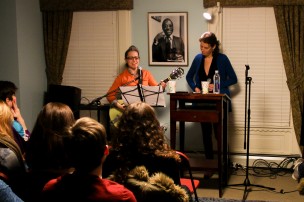
University students and faculty were treated to a performance in the Shapiro Creative Writing Center on Tuesday, Feb. 23. Forty students fit cozily but comfortably into the space, where The Shapiro Distinguished Professor of Writing and Theater Quiara Alegría Hudes and musician Erin McKeown presented several pieces from their new musical, “Miss You Like Hell.” The duo performed five songs, explaining their creative process throughout the performance.
Hudes is an accomplished playwright and composer. She received the 2012 Pulitzer Prize for Drama for her play, “Water by the Spoonful” and wrote the book for “In the Heights.” She has written a number of other plays and is currently teaching “Advanced Playwriting: Long Form” at the University. McKeown is also a recording artist, writer, and producer with nine albums and two EPs and has appeared at music festivals around the world. This is the first musical she has ever worked on.
The team met through a mutual friend of Hudes, who was looking for a composer to write this musical. Both Hudes and McKeown are co-lyricists on the project.
In addition to playing the new music, the presenters aimed to explain the journey that they took, and are still taking, in order to come up with a cohesive story and fitting musical numbers.
“We thought the way to approach [this presentation] is to actually go behind the scenes, since we’re still in the thick of this collaboration,” Hudes said. “[We want to present] the nuts and bolts of how things got written, how ideas were heard, what our influences were.”
This is the first time that the numbers of this play have been performed to a room of people unknown to its creators. Additionally, it was the first time that a musical performance was featured in the Shapiro Center. Senior Fellow Amanda Distler ’15 was pleased to host the innovative event.
“The Shapiro Center is so lucky to have had such an amazing performance, and it’s exciting for us to branch out from the on-the-page, literary work to get to have someone here performing,” Distler said. “This is the first time that we’ve had a real performance with [musical instruments] and everything, and it was amazing, and we hope to keep that intimate kind of vibe going on.”
Hudes and McKeown, with her guitar, performed the opening number, finale, and three songs in between. With each, they revealed more of the musical’s plot and insight on how it came to be. Without giving too much away, they presented a brief summary of the play’s events: A woman whose immigration hearing is closely approaching must beg her estranged daughter to serve as a character witness. Reluctant until the very end, the mother and daughter embark on a cross-country road trip, bonding with each other and meeting a colorful cast of characters, with whom they keep in touch via the daughter’s blog.
The opening number, “Lioness,” was described as a pep talk, which the mother gives herself on her way to make this momentous request. In order to establish tension, they researched and listened to other famous pep talks (such as “Lose Yourself” by Eminem) in order to set the tone they were looking for.
“That first moment of music is one of the hardest to pin down,” McKeown said.
The creation of the other numbers followed a similar pattern of brainstorming and then assembling the elements into a song with a fitting style and lyrics. For example, one of the songs reflected themes of transportation by including references from a variety of well-known books, songs, and historical events, which were all compiled into a massive list by Hudes and McKeown.
The basic structure of the musical was drawn from one of Hudes’ plays, “26 Miles,” with which she was never quite satisfied.
“I didn’t enjoy seeing productions of it, and I always felt like I phoned in some of the writing, or it wasn’t as fully realized as it could be,” Hudes said. “I always thought, ‘How do you do a road trip on stage? Is it possible?’ And then I thought, maybe music would make that possible.”
One aspect of the play, a monologue by a tamale stand owner, was reborn as a song. Hudes considers the monologue to be one of the stronger aspects of the original play.
The play features a diverse group of characters, but Hudes and McKeown did not let that limit their selections of musical style.
“Something that I wanted to bring to this project on the musical side of it is something similar [to Hudes’ ability to write very non-stereotypical characters],” McKeown said. “No matter where people come from…it doesn’t have to map one hundred percent to the music that people listen to.”
The formal presentation concluded with the show’s final number, which involved an integration of all elements of the road trip and the experiences of those they met on it.
“Our task became, ‘How do we build a true lie?’” Hudes said.
A reception followed where attendees had the opportunity to discuss Hudes’ and McKeown’s work with them directly. Matt Hixon ’15 attended the event and spoke to the duo’s work.
“I think she’s doing some really awesome stuff,” he said. “It’s different than her other work…and it’s cool to see some of her different material.”


Leave a Reply